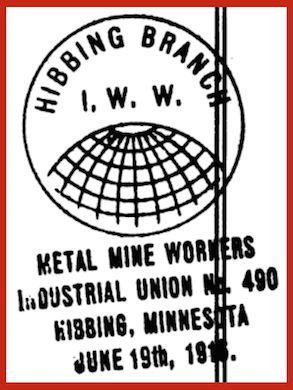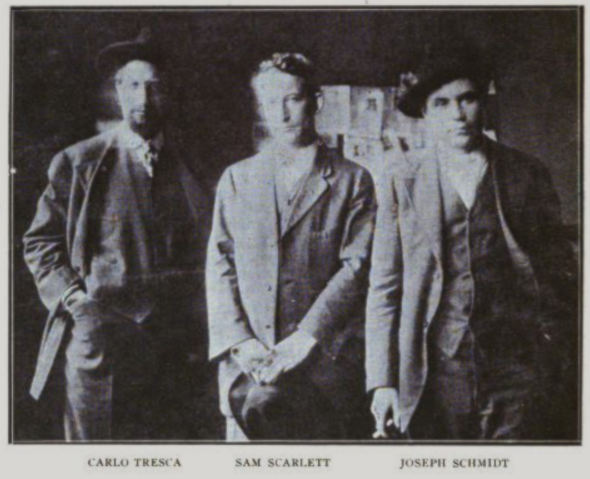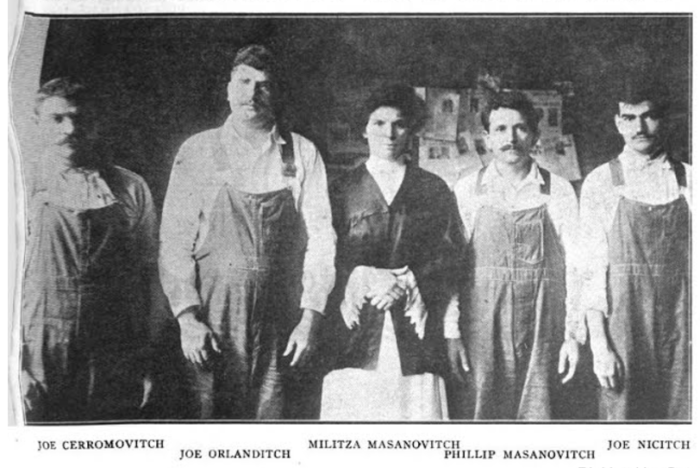You ought to be out raising hell.
This is the fighting age.
Put on your fighting clothes.
-Mother Jones
Hellraisers Journal, Thursday November 16, 1916
Mesabi Iron Range – Low Wages, Company Gunthugs, & Frame-Ups

Writing for the Duluth Labor World of November 11th, Harrison George describes the conditions under which the Mesabi Iron Miners earn their wretched living, the very conditions which led to the bitter strike of this past summer. George also points out how, in Minnesota as in Colorado, deputized company gunthugs can murder with impunity, and indeed the blame for the acts of these drunken brutes falls not upon the perpetrators, but upon the miners who went out on strike and upon the I. W. W. organizers who came to their aid.
GOT $12.70 WEEK, RANGE MINER
SAYS IN AFFIDAVIT
—–BY HARRISON GEORGE,
Special Investigator for The Labor World.
At the invitation of Mr. Downing, the superintendent, the writer recently visited the workings of the Bennett mine on the Mesaba Iron Range of Minnesota.
It was the plain intention of Mr. Downing to absolve himself and his firm, a so-called independent concern, from the general blame and disgrace attached to all Mesaba Range operators as a result of the industrial tyranny brought to light by the recent miners strike.
Giving this concern all due credit for the modern sanitary and safety devices used and the humane spirit Mr. Downing seems to have, together with the rates of wage paid; it was self-evident that this mine was what others in the district could be and were not; that the wage rate was only a reasonable compensation which others would not give and that altogether; the miners recent strike was for demands companies could easily grant and still make a good profit from its toilers.
In fact Mr. Downing would not allow the writer to publish an itemized statement of his wage scale showing an average daily wage paid of $3.45 saying that, “The other operators might get sore about the comparisons to be drawn.”
For men who do the hardest kind of labor in the midst of the danger and darkness of the mountain’s belly, $3.45 per day strikes the writer as being inadequate enough. When you consider that these men must dig the iron ore which makes the machinery of the world and the skeleton of civilization, no one, outside the Steel Trust, will deny that these men are deserving of even more than the Bennett mine pays let alone the unbearable conditions and pitiful wages they struck against last summer.
Affidavits are before me from which I draw the following extracts concerning wage conditions that brought about the strike. Comes Matt M_____n, who swears upon oath
That he worked in the Alpena mine for the Oliver Mining company, during 1915 and up to the strike in 1916, that his average wage during 1915 was about $2.23 per day. That the highest average ever received was $2.98 during February, 1916.
Comes
Peter K_____h, being first duly sworn upon oath says, that (reciting promises of raises not received) the average wage for men in the Shiras mine was from $2.35 to $2.60 per day and no more.
Comes
John D., being duly sworn says, that he is a miner of 17 years experience. That during the month of April, 1916, he worked at the Clark mine for seven and one-half days and was paid for his labor the sum of $12.70 and no more.
Dozens, yes hundreds, of similar affidavits show the insufferable industrial conditions these unorganized toilers struck against last summer. In answer to the striker’s demands the Steel Trust flooded the district with deputized thugs. An armored train was built for these worthies to use, and machine guns were installed to shoot down the citizen strikers. Official brutality rampant, beat, jailed and shot over 600 men and women. The strikers were trying to keep the peace. But these paid trouble-makers would not have it so. Leaving company ground they bull-dozed and even killed citizens upon the public streets and private lots, invading homes to intimidate the miners back to work.
It was in one of these raids that a deputy was killed by one of his own drunken crew. Yet, besides the unarmed strikers who, at most, were defending their homes and persons, three strike leaders were gathered up at distant towns far from the tragedy and charged with complicity in killing the deputy. Altogether, one woman, four strikers and three organizers, Sam Scarlett, Carlo Tresca and Joe Schmidt, were indicted by what the Mesaba Ore, a local paper the Steel Trust cannot buy, called a “hand-picked jury.” Rightly so, as it failed to do its plain duty by refusing to indict Nick Dillon, one of the gunmen in the affray, who, witness swore went out of the house that day and deliberately shot and killed Thomas Ladvalla, an innocent peddler standing in the road. Trials of these strikers begin early in December.
Such are the conditions labor faces in the industrial barony of northern Minnesota, under the control politically and industrially of United States Steel corporation.
———-
[Photograph added.]
From the International Socialist Review of November 1916:
Legal Side Lights on Murder
By ARTHUR LESUEUR
EIGHT men and one woman are under indictment for murder in the first degree, on the Iron Range in Minnesota; this, as a result of the brutal attacks of mine guard deputies in the effort to break the strike of the iron miners. Philip Masonovich, Joe Orlandich, Nick Nickich, Joe Cernogortovich, and Milica Masonovich—the wife of Philip—were attacked in the Masonovich home by mine guard deputies, and, in the fight resulting, one deputy and a bystander were killed. The miners were unarmed. The deputies were all armed, and there were four of them.
To this point, nothing unusual occurs, from the legal standpoint. It is the usual, sordid, soulless tragedy of the effort of corporate wealth to break the spirit of the workers in a strike; but there have been indicted, also, for the same offense and in the same case and for the alleged murder of the same deputy sheriff, four other men; that is: Carlo Tresco, Joseph Schmidt. Sam Scarlett, and Arthur Boose; who were engaged, at the time of the killing of the deputy sheriff, in an effort to organize the miners during the strike.
On July 3 none of these last named men were within twelve miles of the place where the deputy was killed, some of them being sixty or seventy miles from there; and yet they are indicted by the Grand Jury, and the indictment charges them with the killing of the deputy by means of a dangerous weapon, to wit: a gun. If the Grand Jury for St. Louis county, Minnesota, believes that their indictment is a true indictment, and that such a gun exists as would make possible the killing of this deputy by these four men—all of them located at different points, and more than a hundred miles apart, none of them within twelve miles of the place at the time of the killing, and yet all of them committing it with the same gun described in the indictment—they should, in the interests of humanity, convey this information to the warring powers in Europe, so that the very terror of such a weapon would end the war.
The Constitution of the State of Minnesota provides that any one charged with the commission of a crime must be informed “of the nature and cause of the accusation” against him. The indictment, in this case, does not carry any other or further information to these four men, than that they are charged with killing the deputy sheriff with a dangerous weapon, to wit: a gun, on July 3.
This gives them absolutely no information concerning what the State expects to prove against them in the way of connecting them with the killing of the deputy. This is not a new method of procedure on the part of the State. It involves practically the same principles as were fought out in the Haywood case in Idaho, and in the Chicago anarchist cases, wherein men are held bound as principals in the commission of a crime by virtue of things said or done, which had no immediate connection with the commission of the crime, but which are construed by the law as calculated to assist in bringing it about.
In the Iron Range case, there can be no possible contention, on the part of the State, that the four organizers were in any way actually involved in the killing of the deputy, and, therefore, it is to be expected that the State will attempt to prove a case—if it attempts to prove a case at all—on the theory of conspiracy, and, as evidence to back up this theory, proof will doubtless be offered by the State of statements made in speeches by the four organizers.
This shows the unfair position in which the defendants are placed in cases of this kind. They are not informed of the nature and cause of the accusation against them—they do not know what the State will claim they said that incriminates them, until they hear it from the lips of the witnesses on the witness stand. There is then small opportunity, if any at all, to procure witnesses to rebut the statements of the witnesses for the State; and unless they are able to do this, should the State bring witnesses testifying to incriminating statements, imprisonment for life will be the penalty to be visited upon these men—not for any crime committed, but because of their inability to deny the statements attributed to them by mine guards and other low types of criminals.
It is hard to convey to the lay mind the enormous difficulty of such a situation on the part of the defendants. For instance, Arthur Boose is not under arrest. There is no chance to consult with him as to things which he said, and yet, if he made incriminating statements, his statements may be used against all of the others. Unless the rigor of the strict rules, as heretofore applied in similar cases, is abated by the trial judge, the defendants, Tresco, Scarlett, and Schmidt, will have to go on trial, knowing nothing whatever of the things that will be charged against them as connecting them with the crime of murder.
No more striking illustration of the lack of care for the personal rights of a worker, on the part of the State, can be imagined than this. It would be impossible to get a judgment, in a Justice Court, for so much as seventy-five cents, without serving notice to the party against whom it was to be entered, of the nature and cause of the indebtedness, as a basis for the judgment; and yet these men are put on trial for their very lives, without a word of notice as to the things which they must meet in Court.
This is just one of the things which Labor must meet, in its contest with the real power that governs the State of Minnesota, and this power is Organized Wealth. The powers of the State are thus prostituted to the purpose of persecution of the workers who demand fair treatment, and they will continue to be so persecuted until the workers learn the efficiency of organization, and by their solidarity on the industrial field, meet the organized power of wealth with the organized power of brain and brawn.
If every working man and woman in Minnesota belonged to a Labor Union that was class-conscious, and could act in that spirit of solidarity that, actuates organized wealth in all of its dealings with the workers, these men would never be tried, for it is known in advance that they are innocent, and the only reason for trying them is for the purpose of putting out of the way men obnoxious to organized wealth, who are, in a measure, standing between the Steel Trust and its victims.
It ought to be very plain, even to those not versed in the law, why it is necessary for Labor to rally to the defense of these men—all of them—and to the defense of this woman, as well, with finances that will enable them to act instantly and effectively in their own defense, while the trial is going on, in the matter of procuring evidence to meet the case which the State presents against them, which they can not deliberately prepare in advance of the trial, for want of notice.
Labor should rally to the support of these defendants, from coast to coast, as one man, for this reason: That if Labor’s leaders and champions can be “railroaded” on such a flimsy frame-up, and put out of the way for life under such circumstances as are presented in this case, then, indeed, is Labor’s cause hopeless. Labor must protect its own; otherwise, the power of the State, and Organized Wealth that rules the State, will make of Labor nothing but slaves.
[Paragraph breaks added.]
~~~~~~~~~~~~~~~~~~~~~~
SOURCES
The Labor World
(Duluth, Minnesota)
-Nov 11, 1916
https://www.newspapers.com/image/49876698
The International Socialist Review, Volume 17
-ed by Algie Martin Simons, Charles H. Kerr
Charles H. Kerr & Company,
July 1916-June 1917
https://books.google.com/books?id=SVRIAAAAYAAJ
ISR November 1916
https://books.google.com/books/reader?id=SVRIAAAAYAAJ&printsec=frontcover&output=reader&source=gbs_atb&pg=GBS.PA261
“Legal Side Lights on Murder” by Arthur Lesueur
https://books.google.com/books/reader?id=SVRIAAAAYAAJ&printsec=frontcover&output=reader&source=gbs_atb&pg=GBS.PA298
IMAGES
IWW Metal Mine Workers IU No. 490, Hibbing MN, June 19, 1916
https://babel.hathitrust.org/cgi/pt?id=mdp.39015079021849;view=image;size=150;page=root;seq=3;num=1
Tresca Scarlett Schmidt, ISR, Nov 1916
https://books.google.com/books/reader?id=SVRIAAAAYAAJ&printsec=frontcover&output=reader&source=gbs_atb&pg=GBS.PA298
Mesabi Defendants, Biwabik Raid, ISR, Nov 1916
https://books.google.com/books/reader?id=SVRIAAAAYAAJ&printsec=frontcover&output=reader&source=gbs_atb&pg=GBS.PA299
See also:
Hellraisers Journal: Duluth Labor World Deplores Violence of Company Police and Rantings of I. W. W.
https://weneverforget.org/hellraisers-journal-duluth-labor-world-deplores-violence-of-company-police-and-rantings-of-i-w-w/
Tag: Minnesota Iron Miners Strike of 1916
https://weneverforget.org/tag/minnesota-iron-miners-strike-of-1916/
Arthur LeSueur
https://en.wikipedia.org/wiki/Arthur_LeSueur
They’ll Never Keep Us Down – Emily Frantz & Rachel Baiman




